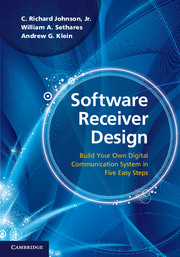Book contents
- Frontmatter
- To the Instructor …
- Contents
- Dedication
- Step 1 The Big Picture
- Step 2 The Basic Components
- Step 3 The Idealized System
- Step 4 The Adaptive Components
- Step 5 Putting It All Together
- Appendices
- A Transforms, Identities, and Formulas
- B Simulating Noise
- C Envelope of a Bandpass Signal
- D Relating the Fourier Transform to the DFT
- E Power Spectral Density
- F The Ƶ-Transform
- G Averages and Averaging
- H The B3IG Transmitter
- Index
B - Simulating Noise
from Appendices
Published online by Cambridge University Press: 05 June 2012
- Frontmatter
- To the Instructor …
- Contents
- Dedication
- Step 1 The Big Picture
- Step 2 The Basic Components
- Step 3 The Idealized System
- Step 4 The Adaptive Components
- Step 5 Putting It All Together
- Appendices
- A Transforms, Identities, and Formulas
- B Simulating Noise
- C Envelope of a Bandpass Signal
- D Relating the Fourier Transform to the DFT
- E Power Spectral Density
- F The Ƶ-Transform
- G Averages and Averaging
- H The B3IG Transmitter
- Index
Summary
Noise generally refers to unwanted or undesirable signals that disturb or interfere with the operation of a system. There are many sources of noise. In electrical systems, there may be coupling with the power lines, lightning, bursts of solar radiation, or thermal noise. Noise in a transmission system may arise from atmospheric disturbances, from other broadcasts that are not well shielded, and from unreliable clock pulses or inexact frequencies used to modulate signals.
Whatever the physical source, there are two very different kinds of noise: nar rowband and broadband. Narrowband noise consists of a thin slice of frequencies. With luck, these frequencies will not overlap the frequencies that are crucial to the communication system. When they do not overlap, it is possible to build filters that reject the noise and pass only the signal, analogous to the filter designed in Section 7.2.3 to remove certain frequencies from the gong waveform. When running simulations or examining the behavior of a system in the presence of narrowband noise, it is common to model the narrowband noise as a sum of sinusoids.
Broadband noise contains significant amounts of energy over a large range of frequencies. This is problematic because there is no obvious way to separate the parts of the noise that lie in the same frequency regions as the signals from the signals themselves.
- Type
- Chapter
- Information
- Software Receiver DesignBuild your Own Digital Communication System in Five Easy Steps, pp. 412 - 415Publisher: Cambridge University PressPrint publication year: 2011



